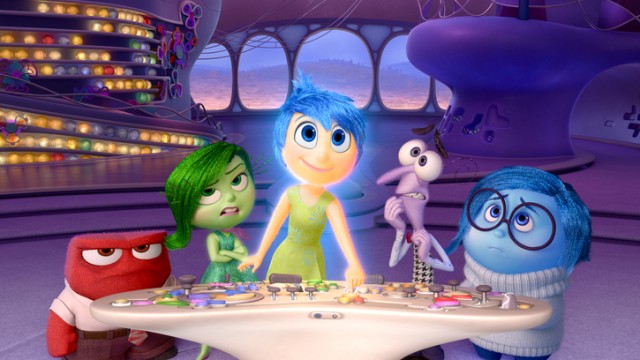Sometimes, stories with high concepts can go awry, Maybe the filmmakers got too bogged down in trying to utilize every new corner of the universe they created that they got distracted from the task of actually making a cohesive story. Despite the numerous paths that the plot at the center of Insider Out could have gone down, I’m elated to tell you, dear reader, that it does not lose itself. This is a tightly crafted, exceptionally written tale that delves into the inner psychology of the mind in a manner that can create enormous laughs or a flood of emotions at the drop of the hat.
Oh hey, speaking of emotions, I think it’s time for you to meet Joy (Amy Poehler), the star of Inside Out. She’s part of the five emotions (the other four being Sadness, Disgust, Anger and Fear) in Rileys head that try to keep her life in order. Joy is the leader of the pack, and the way she’s presented to the audience is one of the best parts of the screenplay Pete Doctor, Meg LeFauve and Josh Cooley created. Her exuberance to make every day perfect for Riley could become irritating so easily, but the story toes a fine line between making her too over-the-top and too passive. Another primary component of why the character works so well is that Poehlers vocal performance excels at making Joys personality so lovable and believable.
Right by Joys side for much of the movie is Sadness, played by Phyllis Smith. As you might imagine by their names alone, the two emotions have a tendency to not see eye-to-eye, and it’s a testament to both actors, as well as the writing and animation of their interactions, how the exchanges between the duo manage to strengthen both characters in unorthodox ways. It doesn’t hurt that Phyllis Smith has excellent comic timing and is able to nail some of the most humorous lines that Sadness delivers in the film.
The world these emotions inhabit is erupting with color and activity, with the films tenacious ability to make every crevice and corner of this universe have some sort of meaning coming to the forefront in every area Joy and Sadness inhabit. This sort of design provides a striking contrast to world of reality that Riley occupies, with places like her San Francisco home and her school being created in a process that accentuates realism and a run down quality. Interestingly, design isn’t the only sector of Inside Out where the real world and the emotions in Rileys head connect in some shape or form.
Conceptually, the very idea at the center of Inside Out (a look at the emotions inside a persons head) is a complex one, and thankfully, the movie doesn’t run away from the challenges the story presents. Perhaps the greatest challenge is to make sure both the primary plot dealing with Joy and Sadness carries emotional heft without giving short thrift to Rileys story and vice versa. But like I said, this sort of ordeal doesn’t inhibit Inside Out; on the contrary, the connection between the human characters the little voices inside their heads provides one of the funniest scenes of the entire feature.
Managing to balance both perspectives is only one of the numerous achievements that this whip-smart movie manages to accomplish in its running time. However, when considering its numerous coups, perhaps the best is how Inside Out handles Joy, Sadness and Riley in its final scene. Where these characters go in the course of this adventure defies expectations in a mature approach that was extraordinary to witness. It just shows how, even when working with a high concept like the one seen here, director Pete Doctor would rather focus on subverting conventions and taking audiences on an astute journey that I surely won’t be forgetting any time soon.

